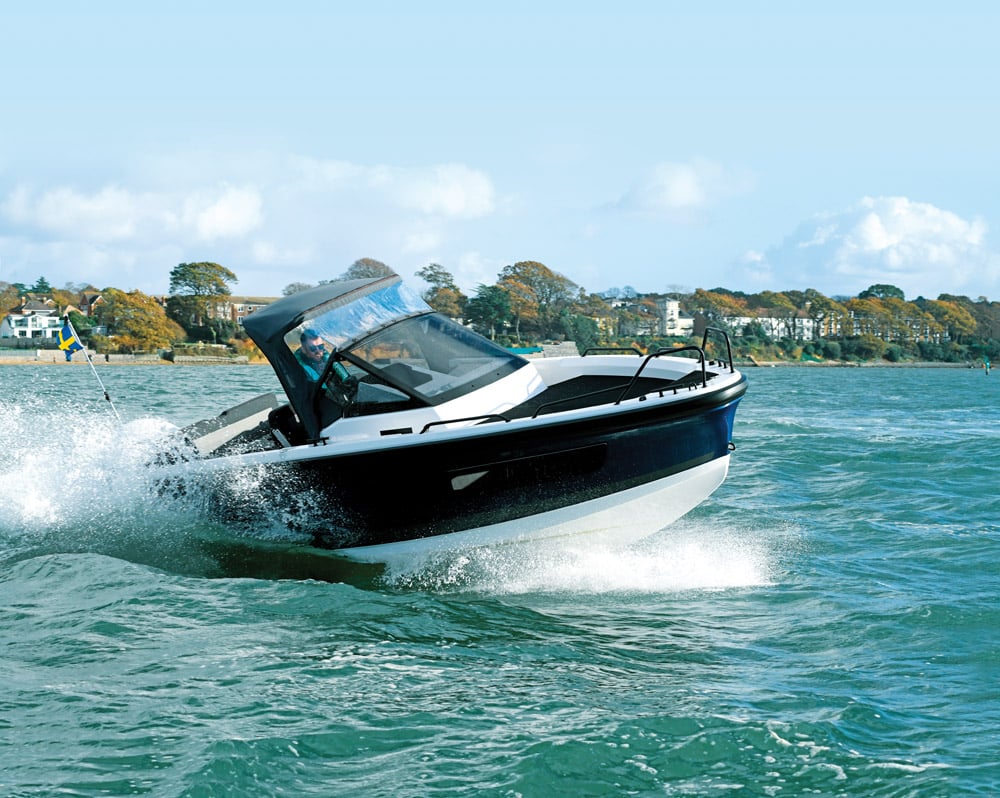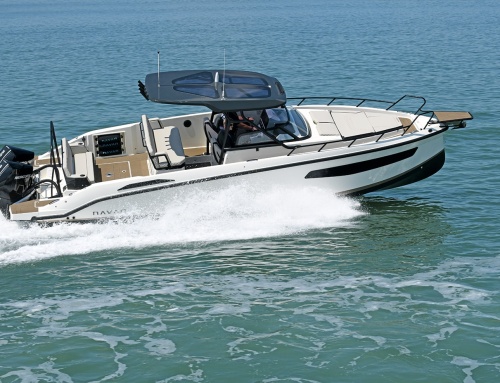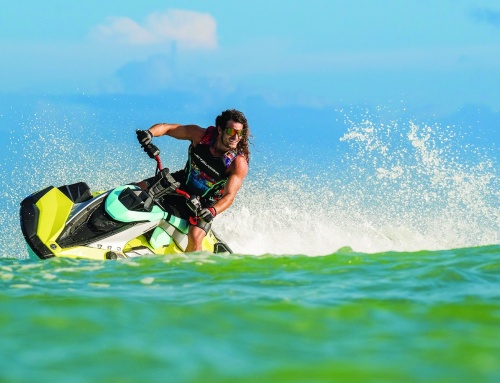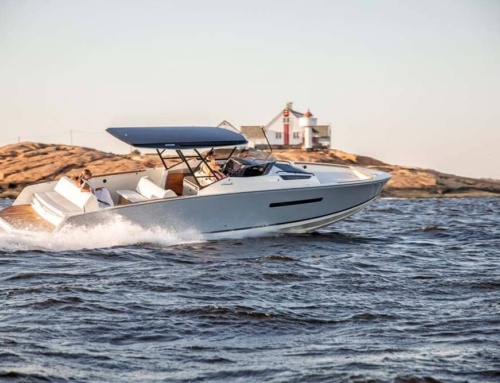Punchy and packed with features, this pocket cruiser is built for all climates. Greg Copp runs his eye over a Swedish newcomer to the UK market …
It is around this time of year – post Southampton Boat Show – when we see previously unknown boats emerge on the UK market. Ryds, roughly pronounced ‘Rudes’ in Swedish, are one of these newcomers, with the 735 VI being the company’s flagship. It is an eye-catching boat with a sensibly big rubbing strake and an appealing blue hull. Ryds have been making boats for some time, and in the case of the 735 VI, they use vacuum infusion in the construction, making the boat lighter and stronger in the process.
It is both a walk-around boat and a cabin weekender. The only compromise in this dual identity is that to walk around you have to step up to the inset foredeck, and there is not the security of forward bulwarks. However, all synthetic EVA decking is soft and grippy, and there are zero trip hazards forward. The fender rails are powder-coated aluminium and the cleats are generous, but the nicely lined forepeak anchor locker on our test boat was empty. Being Scandinavian, this boat is normally supplied with a stern anchor under the port-side bathing platform, which for UK boats will become fender storage, with an anchor fitted forward.

Thanks to the bathing platform configuration, access to the cockpit can be through either quarter. Six can sit down around the folding table, courtesy of a bit of simple innovation. First, there are two fold-out platforms on each beam, which, once fitted with cushions, become short bench seats. Alternatively, when folded and locked vertical against the bulwark, there is more deck space. The double helm seat backrest can be reversed to face aft, while the transom bench seat, using the same concept, can either serve as a dining seat or as the perfect perch to watch waterskiers. Surprisingly, the hi/lo table does not serve as an infill support for a sunbed insert, but I would not be surprised if Ryds were to introduce this further down the line.

Comfy dining for six.

The hidden galley.

The bathing platforms provide easy access.
What has started to become de rigueur when space is premium is folding the helm seat forward to reveal the galley. With the 735 you get a sink, workspace and a diesel hob, the tank for which sits in the locker beneath, with a 40L fridge next to it. It is simple, but the reality is that a couple could have a comfortable weekend away on this boat, without having to resort to the local eatery all the time. Our test boat had the front section of the cockpit bimini/cover set fitted, which, when complemented by the aft section, encloses the rear part of the boat, while still providing forward access on each side of the console. Sensibly, this front section can be quickly folded down over the front of the console and secured at deck level in a storage bag while still fitted to its frame. There is also a smaller cover set known as the ‘Driver’s Hood’, which fully encloses just the helm. With the diesel heating option, you can skipper this boat in the sub-zero conditions that its Swedish creators intended it for.

The windscreen offers plenty of protection.

Two steps up to the foredeck.

A large sunbed can be fitted onto the foredeck.
Externally, the Ryds is misleading in terms of below-decks accommodation, as opening the cabin door reveals much more space than you expect. The design pushes the double bed out to the extremities, with the mattress sections also serving as a sunbed for the foredeck – which gives an indication of the size. Internally, the cabin is neatly lined and fitted with various inset lights, and it has a storage locker on the port side. There is no escape hatch, but full-length windows provide plenty of natural light, and with the extra height and light in the doorway, you do not get that shoebox feel that many 24-footers suffer from in the cabin. The heads compartment will certainly appeal to most. It is a sit-down affair as you would expect, but the electric toilet, sink and vanity unit, accessed by a concertina door, is well put together.

A large double bed for a 7.2m boat.

The heads – compact but capable
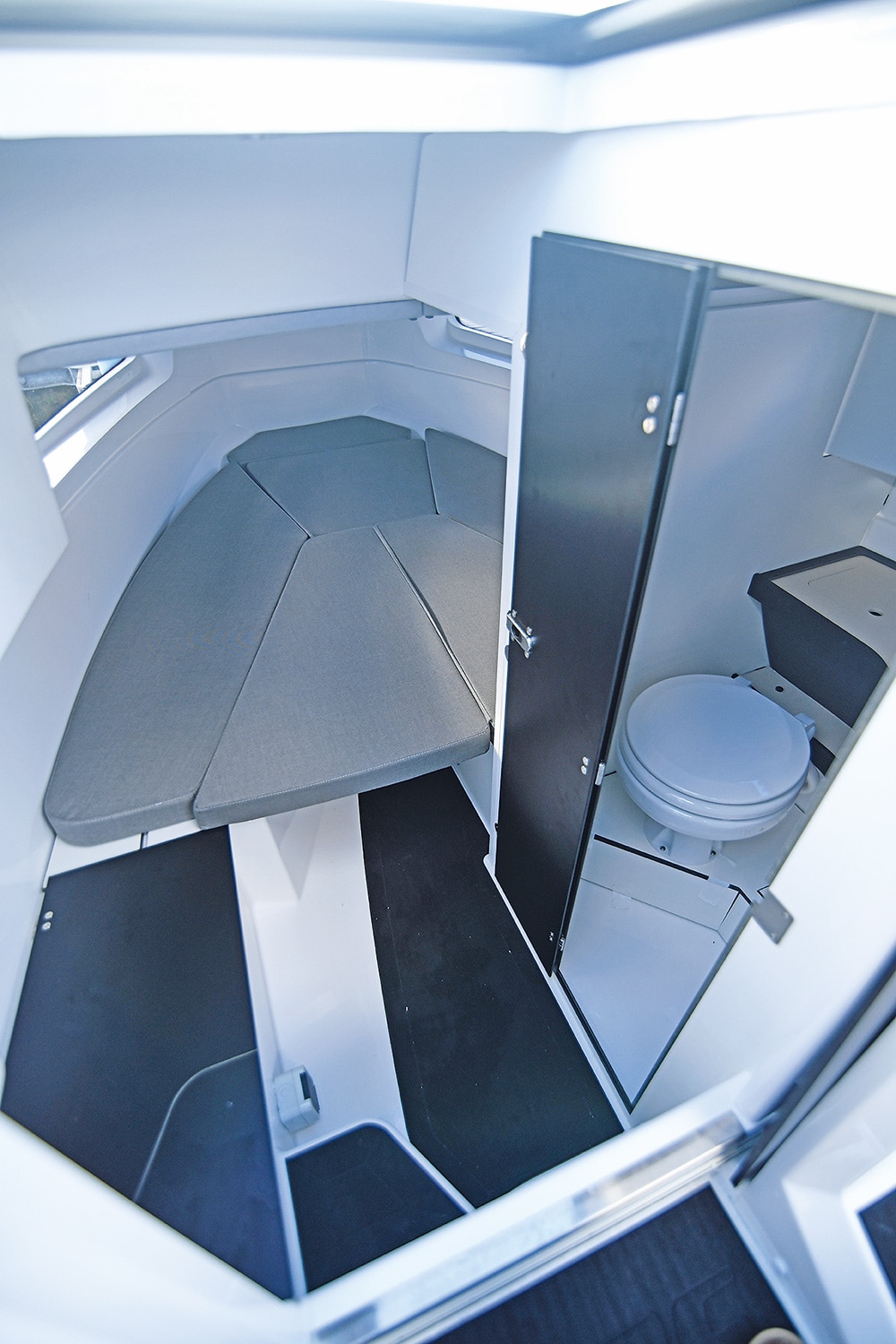
Plenty of headroom in the doorway.
Behind the wheel
We had the front section of the Driver’s Hood up since the weather was looking dubious. Even so, the windscreen itself is pretty tall, so windblast is never going to be an issue without the extra cover. If you are going to drive this boat in a ‘spirited manner’, you will most likely stand for a better view. The wheel is not adjustable, but I had no problems with it. Though the throttle comes to hand easily, you do not get any support for your right arm, which made powering out of tight turns a bit ‘all or nothing’. The low-down power delivery of the Yamaha F250 is such that you often try to ‘fine-tune’ your right hand, which would be easier if your right forearm had an anchor point like an armrest.
I liked the dash layout, with the 16in Garmin MFD central, the engine display just to the left and the Zipwake automatic interceptor panel immediately beneath that. The Zipwake system had been set up, which is not always the case with test boats, so all I needed to do was keep an eye on the Garmin and the Yamaha display.

The helm packs plenty into a small space.
The grunty low-down power delivery of the F250 always impresses, suitably accompanied by a muscular V6 growl. The power-to-weight ratio of the Ryds with this engine option is where this boat needs to be for a responsive drive, which it certainly provided. The boat was up to 40 knots in just over 10 seconds, and with 30% trim out she pushed up to 47 knots without any problems, and the ride was pretty composed. Though I was unable to confirm the transom deadrise angle, on the basis that the 735 VI is the product of the Mannerfelt Design Team, I feel it is fair to say that the hull is deep-vee, though not excessively so. Running at 40 knots into the short, sharp chop of an F4–F5 did produce the odd complaint, which mainly sounded like the concertina door to the heads. This boat does have quite a bit of beam for its length, so running into the weather is unlikely to be its strong point, though the hull flare provides a dry ride. With the sea astern, she is a lot quieter. I generally found the ride to be composed in most sea states, notably running obliquely over the wave pattern, where the forward buoyancy of her beam helped in terms of stability.
She certainly can cut some tight turns. Yamaha’s electronic power steering makes it very easy to throw this boat about, and the pickup provided by the F250 means you may need to exercise some caution. The hull has a degree of hull slide when driven hard in the corners, followed by a tendency to grip and bite. It is not too hard to get used to this and even enjoy it, but subsequently you tend to feather the power on and off, which would be easier if your forearm had some support, as mentioned earlier. Though it does enliven the concept of cutting a tight line, the helmsman also needs to set themselves up first by pushing their feet out hard against the angled footboard.

Verdict
Realistically, the 735 VI is a Grand Turismo rather than a total sports boat, and a capable one at that. In basic form, she is quite keenly priced at £85,000, though most people will not choose the basic 175hp Yamaha F175. The F200 is a more realistic option if you just want a 40-knot boat, as this engine is quite capable of powering this craft. The F250 does give it a relaxed power delivery in terms of cruising, as at 30 knots she returns a healthy 3.2nmpg without seeming to break sweat. Equally importantly, safety, weather protection and the typically innovative Scandinavian design make this model and this brand ideal for family use.
What we thought
For
- Build quality
- Responsive steering
- Innovation
- Fit and finish
- Accommodation
- Good performance
Against
- There is some hull slide when driven hard in the turns
Specifications
- LOA: 7.2m
- Beam: 2.58m
- Draught: 0.85m
- Hull: Mild deep-vee
- Displacement: 1450kg (dry, no engine)
- Power options: Single 175hp Yamaha F175 – single 250hp Yamaha F250
- Fuel capacity: 250L (55 gal)
- RCD category: C
- Test engine: Single 250hp Yamaha F250
Performance
- 47.2 knots (2-way average), sea conditions F4–F5, crew 2, fuel 40%
- 0–30 knots: 7 seconds
Price
- From: £84,958 (inc. VAT)
- As tested: £119,950 (inc. VAT)
Contact
Boatpoint Ltd, Deacons House, Bridge Rd, Bursledon, Hampshire SO31 8AZ

